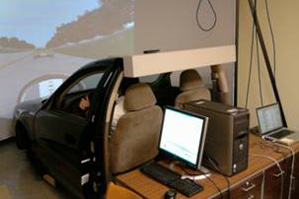Human-machine interactions, the natural way

 When mechanical and industrial engineering professor Yingzi Lin was pursuing her PhD in vehicle engineering, one of the driver test subjects became so distracted by the sensing equipment in the vehicle (the researchers were collecting data about his physiological state while driving), that he got into an accident. This experience got Lin thinking, “how could these experiments be as least disruptive for the test driver as possible?” She began to explore that question in the context of research trials, but soon found that the applications were boundless and applied to real-world scenarios as well.
When mechanical and industrial engineering professor Yingzi Lin was pursuing her PhD in vehicle engineering, one of the driver test subjects became so distracted by the sensing equipment in the vehicle (the researchers were collecting data about his physiological state while driving), that he got into an accident. This experience got Lin thinking, “how could these experiments be as least disruptive for the test driver as possible?” She began to explore that question in the context of research trials, but soon found that the applications were boundless and applied to real-world scenarios as well.
After earning her vehicle engineering degree, Lin moved to Canada to pursue yet another PhD in mechanical engineering at the University of Saskatchewan. In 2005 she joined Northeastern and the rest is history. Well…actually, that’s not true. The rest is a story still being told. Lin currently has about seven graduate students each pursuing his or her own research in human-machine interactions, and each with the ultimate goal of making those interactions as seamless and natural as possible.
At the recent NSF Engineering Research and Innovation Conference, hosted by Northeastern, Lin and her students presented thin films that incorporate a variety of physiological sensors into the materials itself. Currently the material is capable of detecting pressure and temperature inputs and now the team is working on getting them to detect blood volume pulse/heart rate signals as well. Lin originally thought of the material as a skin to go over the steering wheel of a test car, so that researchers could collect data on the physiological state of a driver without interfering with his or her natural experience of the environment. An added benefit, she said, is that the films do a better job of integrating the various signals.
Lin is interested in drivers because of the broad social impacts such an area has, she said. For example, vehicle accidents are still a leading cause of death despite advanced safety technologies and even infrastructure development. If someone is tired or angry, current technology can’t keep them from veering off the road or making a rash decision in the heat of the moment. “About 16 million Americans have road rage issues,” said Lin, who doesn’t expect that Americans are alone here. If we can detect a driver’s emotional state, for example through elevated blood pressure and body temperature, we could potentially intervene at a critical moment to either calm them down, wake them up or alert other drivers or officials of a problem.
Of course, the car is not the only place where humans interact with machines. In our increasingly tech-savvy world, rarely an hour goes by that we don’t interact with a machine of some kind. Lin is pursuing natural sensing design in research projects as far reaching as physical therapy interventions, web site design and telemedicine, to name a few.




